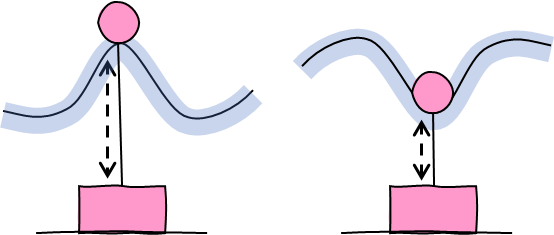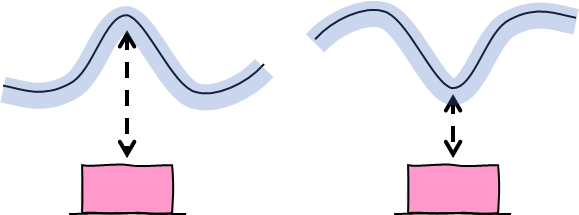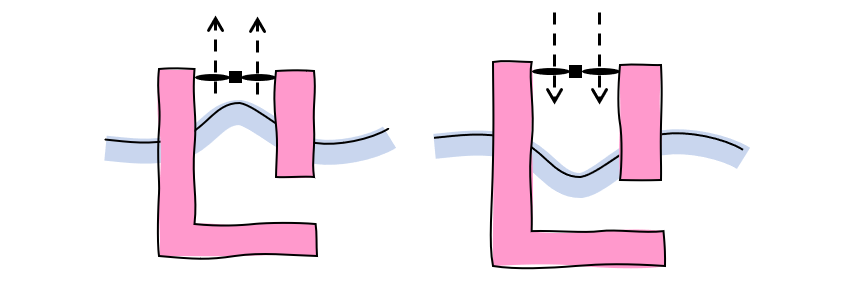The ocean covers 70% of the earth’s surface, so it is no wonder there is a significant attention at the moment on offshore renewable energy. Whilst the current focus is largely on offshore wind, there are other ways that energy can be captured offshore, such as offshore solar, ocean thermal energy conversion (OTEC), and tidal. Another approach, of course, is seeking to capture energy from waves themselves. Wave energy is at a particularly interesting point in its development as there are many different innovative ways engineers are attempting to capture energy from the motion of the waves, with no clear winner. We explore five of the approaches being taken below.
Point absorber
The most common type of device for capturing wave energy is a point absorber. The prevalence of these devices is likely due to their simplicity – in effect a point absorber is simply a float such as a buoy tethered to a fixed base. As the buoy moves up and down in the water due to the heave motion of the waves, it moves towards and away from the base. The reciprocating movement of the tether resulting from this motion can be harnessed to generate electricity. The PowerBuoy from Ocean Power Technologies is a good example of this type of device, except instead of a fixed base, the PowerBuoy makes use of a submerged spar that remains mostly stationary in the waves whilst the buoy moves towards and away from the spar.

Submerged pressure differential
One issue with a point absorber device is that the buoy is at the surface of the water, which means it is exposed to potentially destructive weather forces. Submerged pressure differential devices do not face the same problem. These devices sit below the water surface (often on the sea bed) and use changes in hydrostatic pressure resulting from wave motion to capture energy. When a wave crest passes over a Wave Energy Convertor (WEC), the depth of water above the WEC increases, thereby increasing the pressure applied to the WEC. When a trough passes over the WEC, the pressure drops. This changing pressure can be utilised to capture energy. For example, Bombora’s mWave (which we have discussed previously) uses these changes in pressure to inflate/deflate a flexible membrane to drive air through an air turbine.

Oscillating water column (OWC)
Like Bombora’s WEC, OceanEnergy’s OE 35 buoy (an example of an OWC device) uses the heave motion of the waves to drive air through a turbine. Instead of the use of a membrane, however, OWC devices use the up and down movement of an isolated column of water to capture energy from the waves. This typically involves a structure with a chamber that has two openings: a first opening to the sea and a second opening to the air. The water level in the chamber rises and falls with the waves, which moves air out of and into the chamber. A turbine positioned within the opening to the air is rotated by the flow of air into and out of the chamber to generate electricity.

Surge converter
The WEC types discussed above are mostly concerned with reacting to the up/down (heave) movement of waves. But waves in the ocean don’t just move up and down. In fact, the particles in a wave follow a circular or elliptical path – they move forward and backwards in as well as up and down. Surge converters (named after the forward/backwards motion of a vessel) generate electricity in response to this forward/backwards movement. Typically surge convertors, such as AW-Energy’s WaveRoller involve a panel connected to the seabed by a hinge, like a door. The panel pivots back and forth, a bit like sea kelp, in response to wave motion and that movement is used to pump a fluid which ultimately drives a generator to generate electricity.

Rotating mass
Typically, when designing a vessel you want to ensure some level of stability. The Wello penguin – which is something of a nightmare for those prone to seasickness – is intentionally designed to be unstable. The unique shape of the device means that as it is passed by waves it gyrates in a circular motion in response to the waves. This motion rotates a mass held within the hull of the device and that rotation can be used to generate electricity.

Summary
Why has wave energy not yet taken off? One reason is simply that the ocean is a very harsh environment – it is difficult and expensive to install and then maintain a device located in the ocean. For the same reason, it is difficult to design a wave energy capture device that will have a lifetime of sufficient length to make the initial capital expenditure worthwhile. Another issue is that, unlike other types of renewable energy, there is not yet one “favourite” design, so efforts and resources are spread across a wide range of very different technologies.
Nevertheless, there is huge potential in wave energy capture – not only is it a constant source of energy, it is also has the highest energy density of renewable sources. For that reason alone, we think wave energy will at some point in the future play an important role in supplying the world’s energy in a sustainable manner.
Ben is a Partner and Patent Attorney at Mewburn Ellis. Ben is experienced in patent drafting, prosecution and Freedom to Operate within the mechanical engineering, medical device and consumer products sectors. He also deals with filing and infringement issues relating to registered and unregistered designs.
Email: ben.boyd@mewburn.com
/BEN%20BOYD-author.png?width=100&height=100&name=BEN%20BOYD-author.png)
-Dec-29-2025-09-11-25-2361-AM.png)
